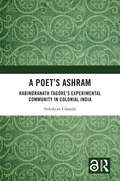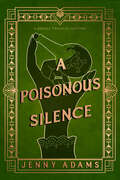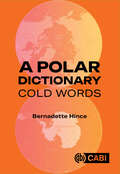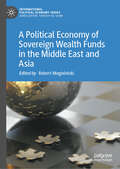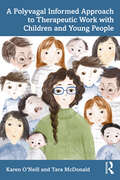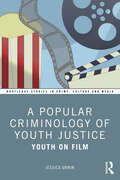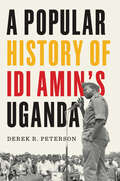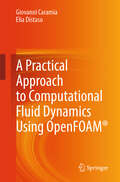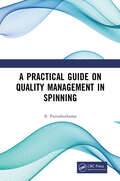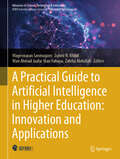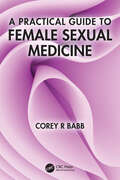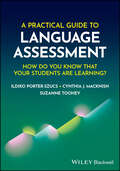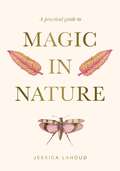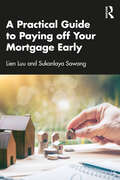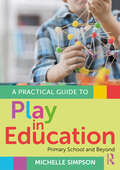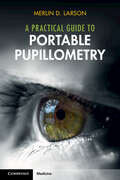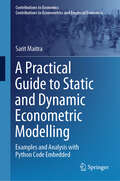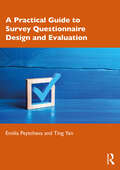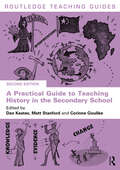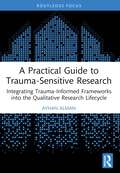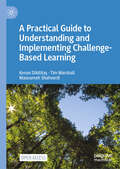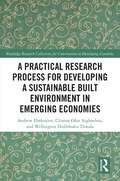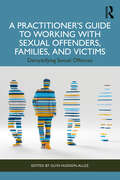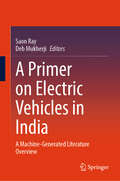- Table View
- List View
A Poet’s Ashram: Rabindranath Tagore’s Experimental Community in Colonial India
by Sukalyan ChandaThe remarkably creative life Rabindranath Tagore (1861–1941) lived has long been an area of scholarly enquiry. Yet, surprisingly, his role as the founder of an experimental ashram community remains unexplored. A Poet’s Ashram retrieves his idea of his ashram through an exploration of his writings on the institutions he built.The ashram community Tagore endeavoured to create in Santiniketan during the period 1901–1941 was his response to the question of modernity. Through his effort to reinvent the ancient Indian ideal of the ashram, he articulated his idea of a mode of collective living that was meant to be grounded in a set of ethical values derived from India’s civilizational inheritance. This book traces the history of how his ashram school evolved into a community that practised egalitarianism, inclusiveness and creativity through its daily existence. It explores a range of nineteenth- and twentieth-century discourses and Tagore’s engagement with them in order to situate that idea within its historical context, a critical juncture in the history of modern India and the world. This book’s reading of his project unravels its anti-colonial underpinnings and the commonalities it shared with some of the other similar experimental communities that challenged illiberal ideologies and power relations during the early twentieth century.Meticulously researched and perceptively written, this book will be of interest to students and researchers of history, political science, culture studies and postcolonial studies. It will also be of interest to educationists, educators and those interested in colonial modernity, modern Indian history, philosophy of education, institution building, peace, inclusivity and sustainability.
A Poisonous Silence (A Deadly Twenties Mystery)
by Jenny AdamsWhen a film star is poisoned in Prohibition-era Philadelphia, private investigator Edie Shippen is on the case in the second Deadly Twenties mystery, perfect for fans of Deanna Raybourn and Rhys Bowen.Philadelphia, 1921. Edie Shippen has officially started her new career as a private investigator…even though she has yet to book a client. When she runs into an old friend, the film actress Ava Sylvester, Edie is delighted at the chance to rekindle their relationship. But when Ava&’s co-star and new husband, Duncan, dies suddenly, all signs point to Ava. Edie&’s first official case begins in earnest, desperately trying to clear her friend&’s name. Gilbert Lawless has carved out a peaceful existence as a coroner&’s assistant. The last thing he wants is to jeopardize his position by involving himself with Edie Shippen. But when the body count racks up, Gilbert finds himself drawn into Edie&’s investigation on the set of Philadelphia&’s most famous film studio, where everyone seems to have something to hide.As the cameras roll, Edie and Gilbert race to catch a poisoner before one of them ends up being the next body in the morgue. With a glittering Roaring Twenties backdrop, Jenny Adams sets the stage for the second charming book in the series for fans of Miss Fisher&’s Murder Mysteries and Dead Dead Girls.
A Polar Dictionary: Cold Words
by Dr Bernadette HinceThis 'ice-breaking' book collects the English words of the Antarctic and the Arctic for the first time. These words relate to weather, ice and snow, auroras, clothes, food, housing, social structures, wildlife, plants, politics, as well as many other aspects of polar life. The terms are presented with scientific precision, a helpful interpretative commentary and moments of irresponsible whimsy. Apart from Antarctica and the Arctic, the regions covered here stretch to places as remote as the Faroe Islands, Iceland, Tristan da Cunha and the Falkland Islands.
A Political Economy of Sovereign Wealth Funds in the Middle East and Asia (International Political Economy Series)
by Robert MogielnickiThis book on sovereign wealth funds (SWFs) in the Middle East and Asia brings together leading scholars and practitioners focusing on investment trends in two prominent and influential regions of the globe. The resulting political economy mapping of these investment vehicles breaks new ground in elucidating prominent geographic contours of the global SWF sector. The interregional framing likewise reveals the strategic economic significance of SWF-facilitated linkages between the Middle East and Asia. The work probes three cross-cutting themes. The initial chapters explore the dynamics of competition and collaboration amongst Middle Eastern and Asian SWFs. This book then turns to the energy, environmental, and sustainability issues shaping SWF investment behavior. Finally, country-specific chapters examine how and why SWF investments materialize within key markets. These interregional connections enabled by sovereign wealth represent an expanding economic frontier with long-term implications for the Middle East, Asia, and the global economy.
A Polyvagal Informed Approach to Therapeutic Work with Children and Young People
by Karen O’Neill Tara McDonaldA Polyvagal Informed Approach to Therapeutic Work with Children and Young People presents a guide to best supporting children and young people through a polyvagal lens.Through this neurophysiological framework of the Polyvagal Theory, the authors consider why children adopt protective strategies, unravelling the mysteries of the nervous system, emotions, and social connection. Linking aspects of attachment theory, developmental trauma, and adverse childhood experiences, the authors explore what shapes behaviour. They delve into perspectives of play and metaphor within the context of the Polyvagal Theory, utilising six storytellers who bring this theory to life, embodying real struggles and highlighting the adaptations children make for survival. Throughout this book, clear explanations, practical examples, and actionable strategies are offered to help the reader to understand and apply a polyvagal framework when working with children and young people.This text is an accessible and important resource for all qualified child therapists, trainees, and professionals interested in the mental health of children and young people.
A Popular Criminology of Youth Justice: Youth on Film (Routledge Studies in Crime, Culture and Media)
by Jessica UrwinAnalysing the representation of youth crime and justice-involved children in popular fictional films, this book explores how what we see on screen contributes to the perceptions of youth justice in society, policy, and practice.Putting forward the argument that fictional representations have a real-world impact on the opportunities available to children, each chapter in the book focuses on a different genre or type of film and considers the ways in which justice-involved children have been demonised, stereotyped, and harmed by their portrayal on the big screen. From James Dean and the birth of “monstrous youth” in Rebel Without A Cause to the current, more nuanced portrayals as seen in The Young Offenders, the book examines films throughout history and across different cultures. In doing so, it demonstrates how portrayals of justice-involved children have contributed to the social understanding of what youth crime is and who is to blame for it, and highlights how we can use this knowledge to better understand and support children.By combining youth justice theory with media analysis, A Popular Criminology of Youth Justice: Youth on Film makes a novel contribution to both fields and will be of great interest to students and researchers in the areas of youth crime, youth justice, and the media.
A Popular History of Idi Amin's Uganda
by Derek R. PetersonHow Africa’s most notorious tyrant made his oppressive regime seem both necessary and patriotic Idi Amin ruled Uganda between 1971 and 1979, inflicting tremendous violence on the people of the country. How did Amin’s regime survive for eight calamitous years? Drawing on recently uncovered archival material, Derek Peterson reconstructs the political logic of the era, focusing on the ordinary people—civil servants, curators and artists, businesspeople, patriots—who invested their energy and resources in making the government work. Peterson reveals how Amin (1928–2003) led ordinary people to see themselves as front-line soldiers in a global war against imperialism and colonial oppression. They worked tirelessly to ensure that government institutions kept functioning, even as resources dried up and political violence became pervasive. In this case study of how principled, talented, and patriotic people sacrificed themselves in service to a dictator, Peterson provides lessons for our own time.
A Practical Approach to Computational Fluid Dynamics Using OpenFOAM®
by Giovanni Caramia Elia DistasoThis book is designed for undergraduate and graduate engineering students who are encountering computational fluid dynamics for the first time in their study of fluid machines. The approach emphasizes a gradual and effective learning process, aiming to minimize the time required to attain a solid foundational understanding. Clarity of exposition is prioritized over strict mathematical rigor, with continuous reference to the physical significance of the mathematical formulas presented. This approach enables students to independently produce acceptable results for most case studies of general interest. The book provides a comprehensive collection of essential concepts needed for correctly configuring any computational fluid dynamics software. To enhance accessibility, it focuses on OpenFOAM, a free and open-source software renowned for its extensive community of developers and users.
A Practical Guide on Quality Management in Spinning
by B. PurushothamaThis book is a hands-on guide that discusses quality management in spinning. It details the techniques, insights and best practices that weave excellence into every fiber. The subject matter of this book discusses the concepts of product objectives and the impact of product features at customer’s end with examples.Print edition not for sale in South Asia (India, Sri Lanka, Nepal, Bangladesh, Pakistan and Bhutan)
A Practical Guide to Artificial Intelligence in Higher Education: Innovation and Applications (Advances in Science, Technology & Innovation)
by Mageswaran Sanmugam Zuheir N. Khlaif Wan Ahmad Jaafar Wan Yahaya Zaleha AbdullahThis book explains how educators can use artificial intelligence in education to enhance student engagement and improve learning outcomes by sharing best practices for using AI to enhance learning quality and foster sustainable teaching. This book covers various topics related to the use of AI in education, from designing activities to using AI in teaching to using AI in assessment by following the ethical considerations of using AI in teaching. The book not only discusses the related topics to using AI in education, but also presents best practices of using AI in teaching and learning from different countries and provides best practices of ethical considerations based on lives experiences of the authors. Furthermore, the book introduces the teaching methods of integrating AI in teaching and learning. Therefore, this book offers essential information and a practical guide to using AI in education.
A Practical Guide to Female Sexual Medicine
by Corey R BabbThe appropriate diagnosis, management, and even terminology for women with sexual health problems have all been much debated in the past few years. This practical text aims to guide the gynecologists, urologists, family physicians, and other professionals involved with the care of these patients. With case presentations, treatment algorithms, and schematic illustrations, this comprehensive yet accessible text will be an invaluable reference for the current state of the clinical art. Provides an accessible guide to a very contested area of patient care Offers a comprehensive resource for the gynecologists, urologists, and family physicians involved in care for patients with female sexual dysfunction Presents a concise and practical route through the clinical details a professional physician needs for patient diagnosis and management
A Practical Guide to Generative AI Using Amazon Bedrock: Building, Deploying, and Securing Generative AI Applications
by Avik BhattacharjeeThis comprehensive guide gives you the knowledge and skills you need to excel in Generative AI. From understanding the fundamentals to mastering techniques, this book offers a step-by-step approach to leverage Amazon Bedrock to build, deploy, and secure Generative AI applications. The book presents structured chapters and practical examples to delve into key concepts such as prompt engineering, retrieval-augmented generation, and model evaluation. You will gain profound insights into the Amazon Bedrock platform. The book covers setup, life cycle management, and integration with Amazon SageMaker. The book emphasizes real-world applications, and provides use cases and best practices across industries on topics such as text summarization, image generation, and conversational AI bots. The book tackles vital topics including data privacy, security, responsible AI practices, and guidance on navigating governance and monitoring challenges while ensuring adherence to ethical standards and regulations. The book provides the tools and knowledge needed to excel in the rapidly evolving field of Generative AI. Whether you're a data scientist, AI engineer, or business professional, this book will empower you to harness the full potential of Generative AI and drive innovation in your organization. What You Will Learn Understand the fundamentals of Generative AI and Amazon Bedrock Build Responsible Generative AI applications leveraging Amazon Bedrock Know techniques and best practices See real-world applications Integrate and manage platforms Handle securty and governance issues Evaluate and optimze models Gain future-ready insights Understand the project life cycle when building Generative AI Applications Who This Book Is For Data scientistys, AI/ML engineers and architects, software developers plus AI enthusiasts and studenta and educators, and leaders who want to evangelize within organizatios
A Practical Guide to Language Assessment: How Do You Know That Your Students Are Learning?
by Ildiko Porter-Szucs Cynthia J. Macknish Suzanne TooheyAn essential resource on effective language assessment, invaluable for a new generation of teachers and education researchers A Practical Guide to Language Assessment helps educators at every level redefine their approach to language assessment. Grounded in extensive research and aligned with the latest advances in language education, this comprehensive guide introduces foundational concepts and explores key principles in test development and item writing. Authored by a team of experienced language teacher educators, this book addresses the potential impacts of poorly designed tools and prepares teachers to make informed, effective assessment decisions. Perfect for developing test blueprints and crafting effective assessment tools, including those for young learners, A Practical Guide to Language Assessment bridges the gap between theory and practice to provide the real-world training educators need to successfully navigate the complexities of modern language assessment. Clear and accessible chapters highlight the critical role of well-designed assessments, emphasize the importance of selecting appropriate tools to accurately measure student proficiency, and discuss recent innovations and emerging needs. With practical examples and a focus on current innovations, including ‘ungrading’ and the use of AI, A Practical Guide to Language Assessment: Explains the foundational concepts of language assessment with practical examples and clear explanations Bridges theoretical principles with practical applications, enabling educators to create effective test blueprints and assessment items and tasks Provides up-to-date coverage of timely topics such as the integration of AI in assessments and the ethical and legal considerations of language testing Features a wealth of in-depth examples of how theoretical concepts can be operationalized in practice A Practical Guide to Language Assessment is an essential read for students in language education, as well as teachers, assessment managers, professional development trainers, and policymakers in language program evaluation.
A Practical Guide to Magic in Nature
by Jessica LahoudThis stunningly illustrated book is a reference guide for magical correspondences found in nature. It is an unmissable resource for understanding and utilising the properties of over 500 natural items, from herbs and crystals to animals, elements, woods, and more. An experienced spellcaster, Jessica Lahoud wants to empower everyone with the ability to integrate these tools into their practice, harnessing the natural energies around us.A Practical Guide to Magic in Nature is a road map to unlocking the enchantment of the natural world. This extensive reference guide sets out to uncover the magical correspondences of more than 500 crystals, plants, animals, the elements and heavenly bodies. Use this guide to discover your innate magic and how you fit into the world of magic surrounding you. Explore the mystical properties of crystals and their extraordinary ability to emanate energy. Discover the age-old wisdom of plants and their profound capacity for healing, the spiritual messages conveyed by the animal kingdom that reveal their role as messengers of the spirit world and learn about the power of planets and stars as they align to influence our collective destiny.
A Practical Guide to Paying off Your Mortgage Early
by Lien Luu Sukanlaya SawangOwning a property is a dream for many people, and borrowing from banks is often essential to achieve this. However, having a mortgage can cause real anxiety because of the latent fear of losing our home if we cannot keep up with mortgage payments. Traditionally, homeowners repay their debt over 25 years, but high house prices have made it necessary to increase the term up to 40 years to make monthly payments affordable. Spreading the debt over a longer period of time not only means that borrowers have to pay more interest, but they are also exposed to other risks such as potential interest rate rises and changes in personal circumstances affecting their mortgage eligibility. These can lead to financial worries, financial stress, and reduced well-being. There are few practical guides available to show borrowers how to manage their mortgage debt more effectively, and how to repay their mortgage quickly so that they are debt-free.This book seeks to empower consumers, young and old, by providing a roadmap to help borrowers achieve financial security through planning for the future, insuring their income, and setting up an emergency fund. It also outlines simple strategies for an early repayment of debt, including paying off the capital, making extra payments, and monitoring their mortgage debt. In doing so, it aims to help readers improve their general well-being, enhance their financial security, reduce their financial worries, and eliminate their ‘mortgage insomnia’.
A Practical Guide to Play in Education: Primary School and Beyond
by Michelle SimpsonThe benefits of play for children’s learning are well-documented and well-researched. The evidence for its positive impact on brain development, social interactions, emotional wellbeing, and motor skills is widespread. So, why should this practice stop after the early years?A Practical Guide to Play in Education encourages teachers to reflect on their practice and consider how a play-based approach may enhance their teaching. It provides realistic, accessible ideas and resources to incorporate into practice while giving evidence to back up this approach. Divided into three clear sections, readers are guided through: An introduction to play in education, including theory, benefits, and potential challenges. Putting it into practice, such as setting up the classroom, resources for play, and adopting a playful ethos in a realistic and accessible way. Lesson plans in a variety of subjects, spanning from numeracy, to literacy, to health and wellbeing. This unique and practical book highlights the importance of play in helping children develop skills to support their future and demonstrates how this approach can be seamlessly integrated into teaching styles across primary and early secondary.
A Practical Guide to Portable Pupillometry
by Merlin D. LarsonThe applications and advantages of portable pupillometry for a wide variety of healthcare providers are becoming increasingly evident, with frequent pupil evaluation becoming the protocol throughout critical care and emergency departments. Authored by a world leading expert, this practical, user-friendly book brings together all the research on portable pupillometry and explains the meaning of the various parameters that new portable pupillometers provide. Starting with the anatomy and physiology of the pupil, the book moves on to discuss pharmacological effects, unusual pupillary syndromes, measurement and size of the pupil, pupillary reflex dilation and pupillary unrest. Additional chapters focus on traumatic brain injury, cardiac arrest, intensive care, opioid effect, acute pain and anisocoria and provide valuable clinical examples and case reports. Also featuring an extensive bibliography for further reading, this book is essential reading for all healthcare professionals using the pupil to evaluate drug effects and ischemic/traumatic insults to the brain.
A Practical Guide to Static and Dynamic Econometric Modelling: Examples and Analysis with Python Code Embedded (Contributions to Economics)
by Sarit MaitraThis book provides a comprehensive guide to econometric modeling, combining theory with practical implementation using Python. It covers key econometric concepts, from data collection and model specification to estimation, inference, and prediction. Readers will explore linear regression, data transformations, and hypothesis testing, along with advanced topics like the Capital Asset Pricing Model and dynamic modeling techniques. With Python code examples, this book bridges theory and practice, making it an essential resource for students, finance professionals, economists, and data scientists seeking to apply econometrics in real-world scenarios.
A Practical Guide to Survey Questionnaire Design and Evaluation
by Emilia Peytcheva Ting YanA Practical Guide to Survey Questionnaire Design and Evaluation summarizes principles, guidelines, and best practices for developing and testing survey questionnaires driven and supported by theoretical and empirical research. It provides a broad overview of literature on questionnaire design, drawing on both theoretical and empirical research.This book consists of three parts. The first covers the survey response process model, which will serve as the theoretical framework to establish the basic principles of writing different types of survey questions (attitudinal, behavioral, demographic, and knowledge). The second part of this book focuses on special topics such as sensitive questions, developing questionnaires for older adults and children, designing a paper survey, designing a web survey and optimizing for a mobile device, developing questionnaires for a multimode survey, and conducting surveys in multiple languages and cultures. The third part of this book describes methods for testing and evaluating survey questions. Topics cover focus groups, cognitive interviewing, expert review, Questionnaire Appraisal System, behavior coding, respondent and interviewer debriefing, randomized experiments, and pilot studies. Given extensive web survey coverage, we also discuss usability testing of web surveys. Finally, we present a brief overview of the use of artificial intelligence and machine learning for questionnaire development and evaluation. Suggestions for further reading, case studies, and discussion questions are included in all chapters.This book will be of interest to those using survey methodology/questionnaires and graduate courses incorporating survey design across the social and behavioral sciences, including psychology, communication studies, nursing and healthcare research, sociology, anthropology, and education.
A Practical Guide to Teaching History in the Secondary School (Routledge Teaching Guides)
by Dan Keates Matt Stanford Corinne GoulléeA Practical Guide to Teaching History in the Secondary School offers comprehensive advice, inspiration and a wide range of tried and tested approaches to help you find success in the secondary history classroom. Covering all aspects of history teaching, it is designed for you to dip in and out of and to enable you to focus on specific areas of teaching, your programme or pupils’ learning.This completely revised edition has been rewritten with new chapters reflecting recent work into curriculum thought, different types of historical knowledge, designing enquiry questions and decolonising the curriculum. Emphasising the importance of pedagogy, detailed subject knowledge, a well-informed and diverse curriculum, evidence-informed practice and a focus on building long-term student understanding in the subject, the chapters cover: Curriculum design Teaching causation and consequence Teaching interpretation and significance Using evidence Delivering a more inclusive and representative history curriculum Progress and assessment Packed with ideas, resources and practical teaching activities and underpinned by the latest research, this is an essential companion for all training and early career history teachers.
A Practical Guide to Trauma-Sensitive Research: Integrating Trauma-Informed Frameworks into the Qualitative Research Lifecycle
by Ayhan AlmanA Practical Guide to Trauma-Sensitive Research showcases the novel idea of trauma-informed interventions for researchers, proposing clinical supervision as the standard rather than the exception. This framework not only aids in managing the aftermath of trauma but also opens new opportunities for both clinicians and researchers.The book details the theoretical foundations of trauma, including the latest insights into how trauma affects individuals and communities, and addresses practical applications of trauma-sensitive methodologies in research. It emphasises ethical considerations, the importance of clinical supervision, and the necessity of adopting a trauma-sensitive approach to protect both research participants and researchers from the potential emotional toll of exposure to trauma. By bridging clinical practices with qualitative research, this book not only opens new professional avenues for clinicians and researchers but also advocates for a research environment that is empathetic, ethical, and informed by a deep understanding of trauma and its impacts.A Practical Guide to Trauma-Sensitive Research will be of great utility to User Experience (UX) Professionals, such as service designers, UX designers, consultants, and researchers involved in qualitative research. Additionally, it will be of value to clinical professionals like social workers, psychologists, and psychotherapists, offering insights and supervision on applying trauma-informed approaches in non-clinical research settings.
A Practical Guide to Understanding and Implementing Challenge-Based Learning
by Tim Marshall Kenan Dikilitaş Masoumeh ShahverdiThis open access book maps the role of challenge-based learning (CBL) in the transformation of higher education pedagogy, towards being sector-informed as well as student-driven. CBL democratises the process of learning by repositioning students as drivers, who are empowered to make decisions on course content, assess needs in the real world and develop opinions. Teachers monitor student learning and engagement and mentor students to express their needs. Chapters showcase existing CBL practices in different settings, and include case studies which detail the practical application of CBL in multiple contexts. The authors develop an emerging theory of practical learning based on the insights of the curriculum designers, practitioners and students. The book will be of interest to researchers, teacher educators/trainers and research supervisors in higher education.
A Practical Research Process for Developing a Sustainable Built Environment in Emerging Economies (Routledge Research Collections for Construction in Developing Countries)
by Andrew Ebekozien Clinton Ohis Aigbavboa Wellington Didibhuku ThwalaA Practical Research Process for Developing a Sustainable Built Environment in Emerging Economies aims to fill the dearth of practical research guidance and reference material with specific focus on the built environment in developing countries. Global policy agendas such as Agenda 2030 (the SDGs) highlight the importance and growth of research and knowledge from emerging nations who are increasingly contributing to research that is critical for development and advancement. The role of built environment practitioners will continue to evolve by building on the sound foundations laid down by the professions and by exploiting to the full the new technologies available to us through conducting innovative research, but more guidance on the research process is necessary to ensure the integrity and quality of the output.This book has been structured so that each chapter is largely free-standing, allowing the reader (undergraduate, postgraduate, or practitioner) to reference the material with ease. It aims to provide practical guidance on conducting research and on writing a dissertation or report and begins by considering the general research background in a built environment context. It then covers research ethics, before moving on to discuss the importance of selecting the right research topic and title and writing a clear abstract. The chapters then cover introducing a research project, and the authors include a section on the problem statement, research questions, aims and objectives, research gap(s), and motivations for the study. The book goes on to cover the literature review section, theoretical and conceptual frameworks, the various types of methodological approaches, and when to apply them. The findings section, discussion of the results, and the study’s implications are then discussed, before the final chapters cover the conclusion and recommendations.The book provides a useful reference for higher education students, graduates, postgraduates, and practitioners engaged in all aspects of construction and built environment research.
A Practitioner’s Guide to Working with Sexual Offenders, Families, and Victims: Demystifying Sexual Offences
by Glyn Hudson-AllezThis unique text aims to cover the many variations of presentations that a mental health professional needs to address in order to conduct effective work with sex offenders and alleged offenders, their victims, as well as their families and children.The book is divided into three sections. It commences with an overview of the criminal justice process and its ramifications, not just for the alleged offender, but also for the wider family and friends who may feel totally out of control over what is happening in their lives, as well as for the victim. It also covers the secondary victimisation of the children of alleged offenders. The next section is designed to take some of the fear out of working with these clients, looking at unexpected specific issues that may be presented with these clients, how to address the client’s trauma history, and how to support them on their journey through the criminal justice system. Chapters include working with non-offending partners, within minority groups like those within the neurodivergent or LGBTQIA+ communities, with women who commit offences, as well as with children and adolescents. Section three covers some of the therapeutic ethical dilemmas within this work, including supervision, confidentiality, safeguarding, and disclosure. Each chapter in the book is written by an experienced, hands-on therapist, giving voice and humanity to their clients.This book is designed for all the mental health workers who find the ubiquitous issue of sexual abuse, in all its forms, coming through their office door.
A Primer on Electric Vehicles in India: A Machine-Generated Literature Overview
by Saon Ray Deb MukherjiThis book presents the result of an innovative challenge, to create a systematic literature overview driven by machine-generated content. Questions and related keywords were prepared for the machine to query, discover, collate and structure by Artificial Intelligence (AI) clustering. The AI-based approach seemed especially suitable to provide an innovative perspective as the topics are indeed both complex, interdisciplinary and multidisciplinary, for example, climate, planetary and evolution sciences. Springer Nature has published much on these topics in its journals over the years, so the challenge was for the machine to identify the most relevant content and present it in a structured way that the reader would find useful. The automatically generated literature summaries in this book are intended as a springboard to further discoverability. They are particularly useful to readers with limited time, looking to learn more about the subject quickly and especially if they are new to the topics. Springer Nature seeks to support anyone who needs a fast and effective start in their content discovery journey, from the undergraduate student exploring interdisciplinary content to Master- or PhD-thesis developing research questions, to the practitioner seeking support materials, this book can serve as an inspiration, to name a few examples. It is important to us as a publisher to make the advances in technology easily accessible to our authors and find new ways of AI-based author services that allow human-machine interaction to generate readable, usable, collated, research content.
